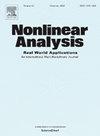包含剪切变形的扩展高梁模型的动力特性
IF 1.8
3区 数学
Q1 MATHEMATICS, APPLIED
引用次数: 0
摘要
本文建立了扩展二维高梁的动力学模型,并进行了数值模拟。在这里,Dyniewicz, Shillor和Bajer (Meccanica, 2024)研究的静态模型通过加入惯性项来考虑动态行为进行了修改。梁模型扩展了1D Gao梁和Timoshenko梁,前者可以在屈曲位置附近振荡,后者考虑了梁截面上的剪切效应。所得到的模型由两个高度非线性的波动方程以及指定的初始条件和边界条件组成。建立并执行了一种有限元算法来分析周期性振荡纵向压缩力引起的系统振动。讨论了模拟结果,突出了初始条件对解的影响方式,并通过相图图形化地说明了这一点。从工程的角度来看,这种厚高梁模型以其相对简单而闻名。与Timoshenko梁模型类似,它包含了剪切效应,产生了一个波状的运动方程。考虑剪切对于准确分析较厚的梁是必不可少的,因为忽略它们的传统模型可能无法捕捉到真实的系统行为。因此,这个扩展的Gao模型在动态场景中提供了更现实的结果。本文章由计算机程序翻译,如有差异,请以英文原文为准。
Dynamic behavior of an extended Gao beam model including shear deformation
This study develops a model of the dynamics of the extended 2D Gao beam and simulates it. Here, the static model studied by Dyniewicz, Shillor and Bajer (Meccanica, 2024), is modified by incorporating inertial terms to account for dynamic behavior. The beam model expands the 1D Gao beam, which can oscillate around a buckled position, and the Timoshenko beam, which factors in shear effects in the beam’s cross sections. The resulting model consists of two highly nonlinear wave equations, alongside specified initial and boundary conditions. A finite element method (FEM) algorithm is created and executed to analyze the system’s vibrations induced by a periodically oscillating longitudinal compressive force. The simulation results are discussed, highlighting the ways the initial conditions influence the solutions, which are graphically illustrated through phase portraits. From an engineering viewpoint, this thick Gao beam model is notable for its relative simplicity. Similarly to the Timoshenko beam model, it includes shear effects, yielding a wave-like equation of motion. Considerations of the shear are essential for accurately analyzing thicker beams, as traditional models that overlook them may fail to capture the true system behaviors. Consequently, this extended Gao model offers more realistic outcomes in dynamic scenarios.
求助全文
通过发布文献求助,成功后即可免费获取论文全文。
去求助
来源期刊
CiteScore
3.80
自引率
5.00%
发文量
176
审稿时长
59 days
期刊介绍:
Nonlinear Analysis: Real World Applications welcomes all research articles of the highest quality with special emphasis on applying techniques of nonlinear analysis to model and to treat nonlinear phenomena with which nature confronts us. Coverage of applications includes any branch of science and technology such as solid and fluid mechanics, material science, mathematical biology and chemistry, control theory, and inverse problems.
The aim of Nonlinear Analysis: Real World Applications is to publish articles which are predominantly devoted to employing methods and techniques from analysis, including partial differential equations, functional analysis, dynamical systems and evolution equations, calculus of variations, and bifurcations theory.

 求助内容:
求助内容: 应助结果提醒方式:
应助结果提醒方式:


